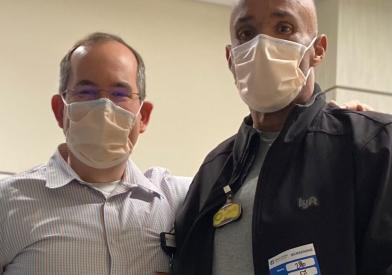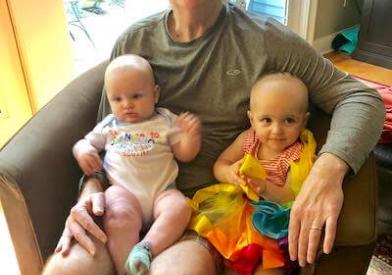What Is Non-Hodgkin Lymphoma?
Non-Hodgkin lymphoma is not a single kind of cancer, but rather a large group of more than 50 cancers that start in cells called lymphocytes, which are part of the body's immune system.
Adult non-Hodgkin lymphoma is a disease in which cancer cells form in the lymph system.
The lymph system is made up of the following:
- Lymph: Colorless, watery fluid that travels through the lymph system and carries white blood cells called lymphocytes. Lymphocytes protect the body against infections and the growth of tumors.
- Lymph vessels: A network of thin tubes that collect lymph from different parts of the body and return it to the bloodstream.
- Lymph nodes: Small, bean-shaped structures that filter lymph and store white blood cells that help fight infection and disease. Lymph nodes are located along the network of lymph vessels found throughout the body. Clusters of lymph nodes are found in the underarm, pelvis, neck, abdomen, and groin.
- Spleen: An organ that makes lymphocytes, filters the blood, stores blood cells, and destroys old blood cells. It is located on the left side of the abdomen near the stomach.
- Thymus: An organ in which lymphocytes grow and multiply. The thymus is in the chest behind the breastbone.
- Tonsils: Two small masses of lymph tissue at the back of the throat. The tonsils also make lymphocytes.
- Bone marrow: The soft, spongy tissue in the center of large bones. Bone marrow makes white blood cells, red blood cells, and platelets.
Non-Hodgkin lymphoma is classified as either indolent or aggressive, based on how it grows and spreads.
- Indolent lymphomas grow and spread slowly, and have few signs and symptoms. They are considered incurable but are often manageable over decades. Examples of indolent lymphomas include follicular, marginal, and lymphoplasmacytic.
- Aggressive lymphomas grow and spread quickly, and patients usually have more obvious symptoms. They are potentially curable. Examples include Burkitt, B-cell lymphoblastic, and diffuse large B-cell lymphoma.
- The treatments for indolent and aggressive lymphoma are different.
There are many kinds of non-Hodgkin lymphoma.
Our understanding of the biology of non-Hodgkin lymphoma has greatly improved in recent years, and the classification system is changing to reflect this. The two main subtypes are B-cell lymphomas and T-cell lymphomas. The subtype is based on whether the cancer cells develop in the body's B-cells or T-cells, which are two forms of white blood cells. The maturity of the B-cell or T-cell also dictates the type of lymphoma that develops.
B-cell lymphoma: Most (about 90 percent) of non-Hodgkin lymphomas in the United States begin in B cells, which make antibodies to fight infection. This kind of lymphoma can grow quickly in the lymph nodes and in the spleen, liver, bone marrow, or other organs. Some common types of B-cell lymphomas include:
- Diffuse large B-cell lymphoma (DLBCL): The most common type of non-Hodgkin lymphoma, DLBCL is a fast-growing cancer. Chemotherapy is often very effective in treating this type of lymphoma.
- Follicular lymphoma: A slow-growing indolent form of lymphoma; treatment varies depending upon the severity of the symptoms.
- Chronic lymphocytic leukemia: A slow-growing form of lymphoma arising from mature lymphocytes found in the blood, bone marrow, lymph nodes, and/or spleen.
Mantle cell lymphoma: This type is fairly rare. It begins in the lymph nodes and can spread to the spleen, bone marrow, blood, and sometimes esophagus, stomach, and intestines. Mantle cell lymphoma inappropriately expresses a protein called cyclin-D1 or a certain gene change in the lymphoma cells. Some cases of mantle cell lymphoma can be indolent; people do not have signs or symptoms and may not need treatment right away. However, in some cases aggressive treatment is needed.
T-cell lymphoma: There are many types of T-cell lymphomas, all of which are fairly rare and less common than B-cell lymphomas. About 10 to 15 percent of non-Hodgkin lymphomas in the United States are T-cell subtypes. Some T-cell lymphomas can be extremely aggressive; others are slow growing. Familiarity with each type is critical to determining the appropriate treatment.
Incidence
The incidence of non-Hodgkin lymphoma has risen over the past few decades. About 70,000 new cases are diagnosed each year in the United States.
Risk Factors
The median age of patients with non-Hodgkin lymphoma is 60, but it occurs in all age groups. Risk factors for adult non-Hodgkin lymphoma include:
- Being older, male, or white.
- DLBCL may affect younger people.
- Burkitt may affect young people, including children.
- Past treatment for Hodgkin lymphoma (however, most people will not develop a second lymphoma).
- Having had an organ transplantation and taken immunosuppressant drugs.
- Having one of the following medical conditions:
- An inherited immune disorder (for example, hypogammaglobulinemia or Wiskott-Aldrich syndrome).
- An autoimmune disease (for example, rheumatoid arthritis, psoriasis, or Sjögren's syndrome).
- A history of human T-lymphotropic virus type I.
- A history of Helicobacter pylori infection.
- Exposure to certain herbicides and pesticides.
There is a possible influence of diet on risk.
Non-Hodgkin lymphoma may also occur in people who have acquired immunodeficiency syndrome (AIDS). These patients require special treatment and need to be monitored for drug interactions. Our infectious disease specialists work with us to plan care for people with both conditions.
Symptoms and Signs
Non-Hodgkin lymphoma can arise in lymph nodes throughout the body, but can also arise in organs. Patients can have symptoms such as swollen lymph nodes, weight loss, fevers, night sweats, a painless or painful lump, and fatigue. Patients with aggressive forms of non-Hodgkin lymphoma are more likely to have symptoms.
Growth and Spread
Most patients with non-Hodgkin lymphoma are diagnosed at an advanced stage. It is rare for the cancer to be localized (in just one place).
Disease-Modifying Therapies
Our researchers are studying the genomic, genetic, and epigenetic factors that characterize conditions that are often "precancerous" at our Center for Early Detection and Interception of Blood Cancers (formerly the Center for Prevention of Progression).


